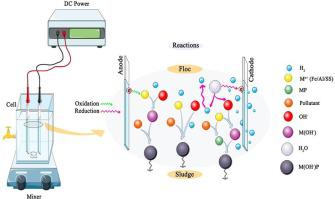Sustainable Energy Technologies and Assessments ( IF 7.1 ) Pub Date : 2021-06-17 , DOI: 10.1016/j.seta.2021.101353 Milad Mousazadeh , Zohreh Naghdali , Zakaria Al-Qodah , S.M. Alizadeh , Elnaz Karamati Niaragh , Sima Malekmohammadi , P.V. Nidheesh , Edward P.L. Roberts , Mika Sillanpää , Mohammad Mahdi Emamjomeh

|
Electrocoagulation (EC) and electrocoagulation-flotation (ECF) are of widespread interest owing to their effectiveness for the simultaneous abatement of a broad range of pollutants in drinking and waste waters, but their capability can vary significantly depending on the operating conditions. The effect of operating conditions on the performance of EC has been the subject of much debate over the last few decades. This review aims to focus on the application of EC/ECF processes for pollutants removal under different operating conditions, emphasizing the principal issues that compose the foundation of EC/ECF. It has been found that the current density (typically 1–20 mA/cm2), type of electrode (Al or Fe), and electrolysis time are the key process parameters that influence performance. Although some key mechanisms of pollutant abatement in EC/ECF processes have been identified, recent studies have begun to reveal how the underlying removal mechanisms using the EC/ECF processes depend on the nature of pollutant. Key mechanisms of pollutant abatement include charge neutralization, reduction–oxidation, and precipitation/co-precipitation. The development of improved or innovative cell designs, as well as systematic modeling of EC reactors, are needed. Future research focused on hybrid technologies with cost-effective energy supply may lead to innovative treatment options for wastewater treatment.
中文翻译:

系统诊断使用电凝作为污染物处理的可持续技术的最新技术:最新评论
电凝聚 (EC) 和电凝聚-浮选 (ECF) 因其可同时减少饮用水和废水中多种污染物的有效性而受到广泛关注,但它们的能力可能会因操作条件而有显着差异。在过去的几十年里,操作条件对 EC 性能的影响一直是争论不休的主题。本综述旨在关注 EC/ECF 工艺在不同操作条件下去除污染物的应用,强调构成 EC/ECF 基础的主要问题。已经发现,电流密度(通常为 1–20 mA/cm 2)、电极类型(Al 或 Fe)和电解时间是影响性能的关键工艺参数。尽管已经确定了 EC/ECF 过程中污染物减排的一些关键机制,但最近的研究已经开始揭示使用 EC/ECF 过程的潜在去除机制如何取决于污染物的性质。污染物减排的关键机制包括电荷中和、还原氧化和沉淀/共沉淀。需要开发改进或创新的电池设计,以及 EC 反应器的系统建模。未来的研究侧重于具有成本效益的能源供应的混合技术,可能会导致废水处理的创新处理方案。











































 京公网安备 11010802027423号
京公网安备 11010802027423号